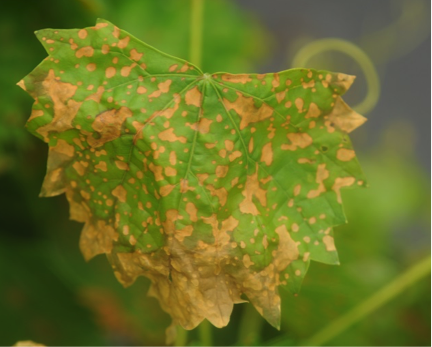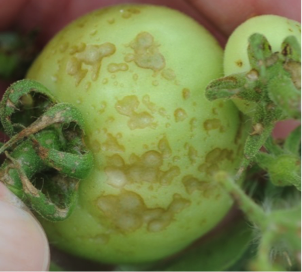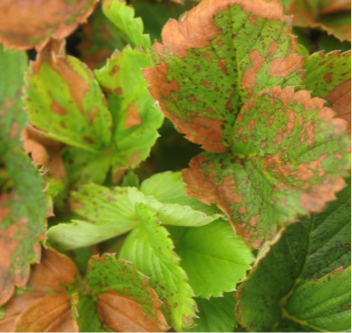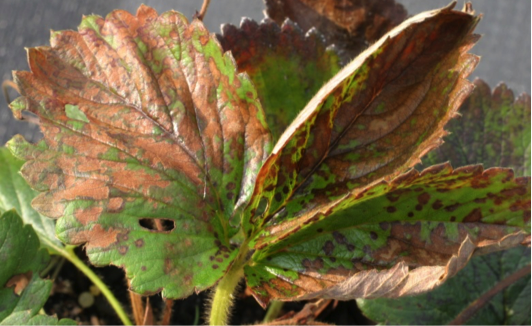Problem
Herbicide injury caused from natural oils and acids including acetic acid (vinegar), caparylic acid, natural oils, d-limonene, long-chain fatty acids, and others.
Symptoms
- Leaf burn. Amount of necrosis will depend on how much spray solution contacts the plant. Direct exposure will result in overall necrosis. Small amounts of spray drift may result in leaf spotting.
- Necrotic spots on fruit when spray drift occurs while plants are forming fruit.
- New, untreated growth will look normal.

Muscadine grape leaf damaged by spray drift from clove oil, 3 days after treatment.
B. Lassiter CC BY-NC-SA 4.0

Necrotic lesions on tomato fruit caused by spray drift from clove oil, 3 days after treatment.
B. Lassiter CC BY-NC-SA 4.0

Strawberry foliage with necrotic margins and spots caused by spray drift from clove oil, 3 days after treatment. Note new growth emerging after spray is unaffected.
B. Lassiter CC BY-NC-SA 4.0

Many contact herbicides may produce similar symptoms of leaf necrosis and spotting. This strawberry plant treated with a PPO inhibitor herbicide, flumioxazin.
J. Neal CC BY-NC-SA 4.0
Plant Entry and Symptom Expression
Naturally occurring oils or acids can be absorbed by any tender tissue resulting in foliar burn to any plant parts if sprayed at high doses or at times of high heat/drought. Young or older treated foliage will show the same symptomology and at the same time intervals with the exception of tissues with thick cuticles, which may not display any symptoms.
Similar Problems
Injury from natural oils and acids injury may be confused with symptoms from:
- Other non-selective, postemergence herbicides including glufosinate, paraquat or diquat.
- Protoporphyrinogen oxidase (PPO) inhibitors including acifluorfen, lactofen, sulfentrazne, oxyflourfen, and others.
- Organic arsenical herbicides (MSMA, DSMA) causing desiccation within 1-2 days.
- Salt stress.
- Prolonged drought stress.
Herbicide Mode of Action Category
No HRAC mode of action categories specified.
Useful Resources
North Carolina Agricultural Chemicals Manual
Southern Region Small Fruit Consortium
Southeastern US Vegetable Crop Handbook
Weed Management in Nurseries, Landscapes & Christmas Trees Information Portal
Herbicide Handbook, Weed Science Society of America
Applied Weed Science: Including the Ecology and Management of Invasive Plants (3rd Edition), Merrill Ross & Carol Lembi, pages 165, 170-172.
Publication date: Sept. 10, 2015
Reviewed/Revised: March 26, 2025
Recommendations for the use of agricultural chemicals are included in this publication as a convenience to the reader. The use of brand names and any mention or listing of commercial products or services in this publication does not imply endorsement by NC State University or N.C. A&T State University nor discrimination against similar products or services not mentioned. Individuals who use agricultural chemicals are responsible for ensuring that the intended use complies with current regulations and conforms to the product label. Be sure to obtain current information about usage regulations and examine a current product label before applying any chemical. For assistance, contact your local N.C. Cooperative Extension county center.
N.C. Cooperative Extension prohibits discrimination and harassment regardless of age, color, disability, family and marital status, gender identity, national origin, political beliefs, race, religion, sex (including pregnancy), sexual orientation and veteran status.
